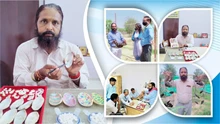
As coconut culture involves substantial pre-bearing investment, greater emphasis must be given to the selection and use of the right type of planting material. By means of a series of selection made at different stages, it is possible to eliminate poor quality seed nuts and seedlings. Based on the research results guidelines for selection of seeds were developed which includes the selection of garden, selection of mother palms and collection of seeds.
Productivity of any crop depends on the quality of planting material. Quality planting material is the key to success in the cultivation of any crop especially in the case of perennial crops like coconut where yield can be realized only after a long period. Coconut Development Board (CDB) has stressed the need to enhance income of coconut growers through effective technology integration.
Speaking at the valedictory of the refresher training programme on Hybridization technique in coconut at the Central Plantation Crops Research Institute (CPCRI) in Kasaragod, Kerala, Usha Rani, Chairperson, CDB, said, coconut farmers, who face price fluctuation need to be supported for better technology utilization to realize higher productivity and income. Farmer-oriented technology transfer initiatives are needed since coconut is predominantly a smallholder's crop, she said.

A coconut breeding project involves
- The identification of the right level of immaturity of the flower spathe in the dwarf mother palm.
-
Manually cutting it open to remove every male flower (10,000 plus) in the spathe, without damaging or touching the female buttons.
-
Scratching the date of emasculation on each leaf stem for the record and easy interpretation of growth in the months to come.
-
Spraying a protective coat of insect retardants.
-
Separately preparing little vials of pollen collected from selected Tall palms, processed in and sent from our laboratory in our estate in Madurai under special conditions to preserve the viability.
-
Manually brush pollinating the female buttons after some days when they mature, one button at a time over a period of 7 to 10 days, as each button matures, requiring a person to visit or climb the tree each time.
-
Counting the number of buttons for the computerized record of every palm – i.e. “Button count”.
-
Checking the button count after 120 days for the record and for estimation of production of seednuts and seedlings in the future.
-
This may be repeated approx 18 times or more per mother palm per month for every spathe that emerges from every leaf.
-
Nuts are harvested depending on the season and the level of maturity of the nut between 11 months and 13 months of age. The records of every single tree are maintained separately and monthly.
An action plan will be formulated to equip the demonstration–cum-seed production farms under CDB to demonstrate technologies for enhancing income from coconut farming.
She also visited experimental plots at CPCRI and held discussions with scientists about the progress of ongoing research projects at the institute with the financial support of CDB.
K Muralidharan, Director-in-Charge, CPCRI, presided over the valedictory function.










